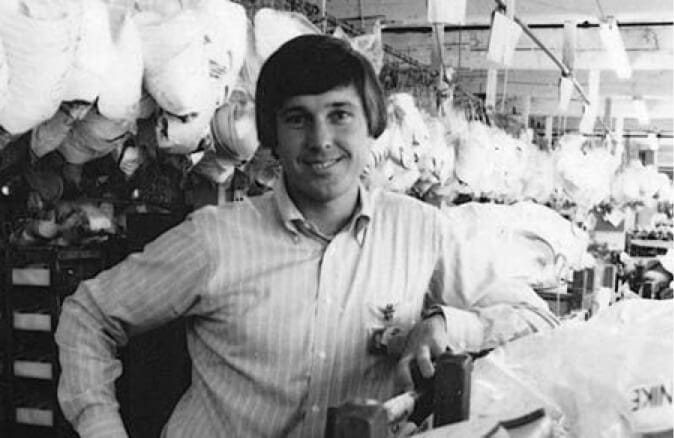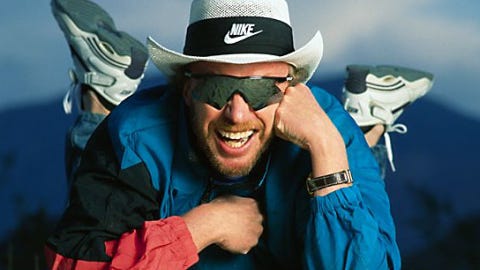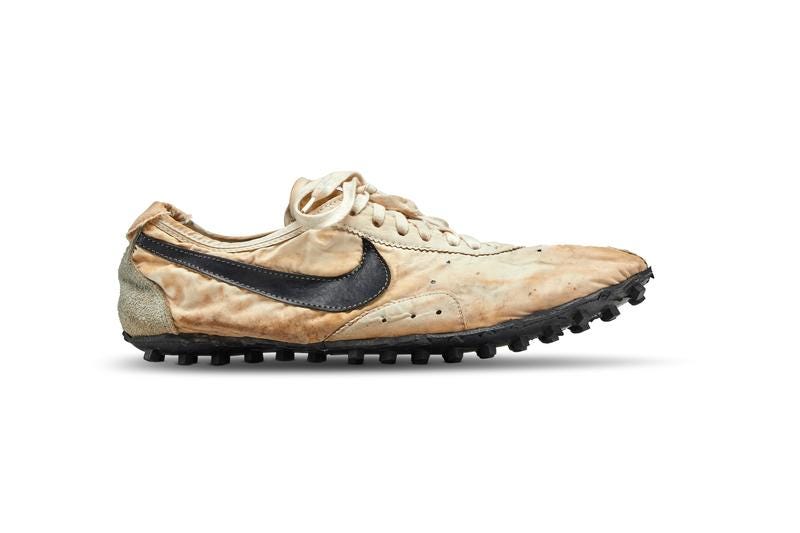👟 Nike
The story of a 7 year pivot, a hostile takeover, and behind the scenes on the creation of one of the most beloved brands in the world. The Nike case study is the best one yet!
Hello folks 👋,
First of all, I would like to welcome the 661 new members to our little family 👨🏽🍼. First 1000 is now 20,761 members strong.
Before going any further, I just want to say thank you to each one of you who tweeted about First 1000, told a friend or two or three, made a Tiktok/Reel or dropped one of our case studies in their slack channels... You are the real MVPs <3
Now to the fun stuff 😃
This week, we are diving deep into the story of Nike. For the past week, I have been devouring Phil Knight's memoir on creating Nike "Shoe Dog."
Nike is unlike any other case study we have covered here on First 1000; it is not a tech company, was founded more than 50 years ago and for the first 7 years of the life of the company wasn't even making shoes.
The History 👵🏻
Before Nike became Nike Inc in 1978, it was known as Blue Ribbon. During that earl(ish) period, Blue Ribbon did not produce any of its own shoes. Instead they were importing Onitsuka Tiger shoes from Japan and selling them direct to runners at first (and later in stores).
The genesis of Blue Ribbon came from a paper Phil wrote during his time at Stanford Business School, where he argued that Japan might be able to disrupt the European-dominated track shoe industry the same way they did the German-dominated camera industry following World War 2.
The low cost of labor, rapid industrialization, government incentives, tax break, and the normalization of diplomatic relations between Japan & the USA in the 1950s combined gave the Japanese a unique edge in the global manufacturing arena. This edge could be observed in Fujifilm's (a Japanese camera company) aggressive expansion overseas in the 1950s. It was not long after that Fujifilm started to make waves in the USA camera market. Phil's argued in his paper that this phenomenon was not unique to the photography industry. Soon enough, the world would see the Japanese dominate all sorts of different manufactured goods. While Phil could've made that argument for virtually any industry, he chose track (running) shoes; track shoes had a soft spot in Phil's heart since he used to track at Oregon (his undergraduate alma mater) until 24.
After completing his MBA, Phil would embark on an I-dont-know-what-to-with-my-life world trip, during which he would make a stop in Japan and convince Onitsuka Tiger (known as Onitsuka at the time) to send him 12 pair of track shoes that he would try to sell in the USA.
That first order took over a year for Onitsuka to fulfill. In 1964 Phil would formally incorporate Blue Ribbon and embark on a journey that would lead him to create one of the most recognizable brands the world has ever seen. A brand so powerful that it would later serve as the main inspiration for Steve Job's renowned "Think Different" campaign.
The road to 1000 👟
Selling the first 12 pairs:
Phil leaned heavily on his Oregon University track coach (Bill Bowerman) for selling the first dozen pairs.
Bill was no ordinary coach; he was obsessed with giving his players a (legal) edge in whatever shape or form he could. Some of the ways he attempted to do just that included tinkering around with his athletes' shoes (and making modifications to them) + inventing a drink to help them recover after long training days (i.e., Gatorade before Gatorade was a thing). Bill would go on to coach over 30 US Olympic athletes.
Phil thought if anyone in the world could discern if these Tiger shoes were any good, it would have to be Bill. Hence, The first thing Phil did after receiving the 12 pairs was to gift coach Bill 2 of them.
Bill loved these shoes so much that he bought almost this first shipment entirely for his team. The cherry on top was Bill deciding to jump in as a 49/51 partner with Phil...becoming the second (and last) co-founder of Nike.
Selling the next 300 pairs:
After the initial success with the test batch, Phil wrote to Onitsuka asking to be their exclusive distributor in the western United States. He immediately ordered 300 pairs
To sell the first "real" shipment of the Onitsuka Tiger shoes, Phil went directly to customers when they were most susceptible to experimenting with a new pair of shoes: track meets.
The opportunity in selling at track meets was that the timeline from purchase to "aha moment" was orders of magnitude faster than through any traditional distribution channel. In under 5 minutes, a runner can purchase a pair of Tigers, run in them on the track, come back, and share their (unique) experience with fellow runners who in turn can buy them right then.
To quote the legend himself:
MY SALES STRATEGY was simple, and I thought rather brilliant. After being rejected by a couple of sporting goods stores (“ Kid, what this world does not need is another track shoe!”), I drove all over the Pacific Northwest, to various track meets. Between races I’d chat up the coaches, the runners, the fans, and show them my wares. The response was always the same. I couldn’t write orders fast enough.
Track sales and the ripple effect of word of mouth contributed to the majority of the sales of the first 300 pairs. Nevertheless, Phil dabbled a little bit with advertising:
Most people who came to the house had found me through word of mouth. Friend of a friend. But a few found me through my first attempt at advertising—a handout I’d designed and produced at a local print shop. Along the top, in big type, it said: Best news in flats! Japan challenges European track shoe domination! The handout then went on to explain: Low Japanese labor costs make it possible for an exciting new firm to offer these shoes at the low low price of $ 6.95. Along the bottom was my address and phone number. I nailed them up all over Portland.
Selling the following 1000 pairs:
As Phil started exhausting track meets around Portland, the next step function was expanding geographically and recruiting a couple of salespeople.
Phil chose California as his first ground for expansion. The only problem, he was not able to afford airfare every week since all his money was tied up in inventory.
To overcome this obstacle, Phil would dress in his army uniform (he was serving in reserves at the time), and left people to "assume" he was an active duty member. Airlines would place him on the subsequent available military transportation to SF or LA- free of charge, of course.
Still, traveling to California over the weekends was not enough to sell all these track shoes (Phil was a full-time accountant at the time & could only travel during the weekends). He needed to hire salespeople.
The first full-time employee and salesman would be Jeff Johnson. Jeff was a fellow Stanford MBA and track runner. Before joining Nike (or Blue Ribbon), he had a little side hustle going selling Adidas shoes.
It took a few months of convincing to get Jeff on board. But as soon as that happened Jeff quickly became obsessed with the Tiger running shoes and Blue Ribbon. The bad kind of obsessed 😬. To an extent where Phil would soon start to question hiring him in the first place.
...the letters didn’t stop. On the contrary, they increased. In length and number. At first they were two pages. Then four. Then eight. At first they came every few days. Then they came faster, and faster, tumbling almost daily through the mail slot like a waterfall, each one with that same return address, P.O. Box 492, Seal Beach, CA 90740, until I wondered what in God’s name I’d done in hiring this guy. I liked his energy, of course. And it was hard to fault his enthusiasm. But I began to worry that he might have too much of each. With the twentieth letter, or the twenty-fifth, I began to worry that the man might be unhinged.
You see, for Jeff, running was life. It went to the point that he wanted to exclusively socialize with people who shared and "understood" that lifestyle (going for a run was something to be mocked in the 1960s). Selling Tiger shoes was the only avenue available to him to connect with fellow runner enthusiasts who could relate to him and running.
Although by accident rather than design, Jeff's desire to personally connect and socialize with other runners would end up being the single most significant lever that helped Nike (Blue Ribbon at the time) sell their first 1000 pairs.
Fun Fact 😁:
In the first year of his employment Jeff alone sold over 3200 pairs of Tiger. This is equivalent to $190,000+ in today's dollars (after accounting for inflation).
He (Jeff) worked seven days a week, selling and promoting Blue Ribbon, and when he wasn’t selling, he was beaverishly building up his customer data files. Each new customer got his or her own index card, and each index card contained that customer’s personal information, shoe size, and shoe preferences. This database enabled Johnson to keep in touch with all his customers, at all times, and to keep them all feeling special. He sent them Christmas cards. He sent them birthday cards. He sent them notes of congratulation after they completed a big race or marathon. Whenever I got a letter from Johnson I knew it was one of dozens he’d carried down to the mailbox that day. He had hundreds and hundreds of customer-correspondents, all along the spectrum of humanity, from high school track stars to octogenarian weekend joggers.....Most wrote him back. They’d tell him about their lives, their troubles, their injuries, and Johnson would lavishly console, sympathize, and advise. Especially about injuries. Few in the 1960s knew the first thing about running injuries, or sports injuries in general, so Johnson’s letters were often filled with information that was impossible to find anywhere else.....Some customers freely volunteered their opinion about Tiger, so Johnson began aggregating this customer feedback, using it to create new design sketches.....Johnson’s Frankenstein flat had space-age, full-length, midsole cushioning. (Today it’s standard in all training shoes for runners.) The jerry-rigged Johnson sole was so dynamic, so soft, so new, Johnson’s customer posted a personal best in Boston.
Deep Dive 🧐: Conviction
Phil has spent the first five years of his time at Nike (Blue Ribbon) working a full-time job, first as an accountant and later as a Professor. However, the people he hired- and arguably the reason how the company managed to double its revenue every year for the first seven years without any external capital- did not only "believe" in the mission, but they lived it and breathed it.
Bill, Phil's ex-tracking coach and co-founder of the company, spent decades of his life trying to improve the weight of his athletes' shoes. Jeff, the first employee, wanted to live in a bubble with other runners who "got him." Bob Woodell (employee #5) and the right-hand man for Phil during the company's formative years, was a standout runner who lost the ability to walk in a frat house accident. Every single person on the "founding team" had a decade-long, complicated history with running.
Some may even argue that they had more conviction in the benefit of running than Phil. Put another way, in 99/1000 parallel universes, had this company not existed, every single person on the founding team would have been something related to running and track.
For your first ten hires, deep-obsessive conviction with the problem or domain trumps skills and/or experience 👏every👏 single👏time👏.The 7 year pivot to Nike
Phil's relationship with Onitsuka would remain solid for seven years, doubling sales almost every year until the executive team at Onitsuka visits the US and see the humble offices of Blue Ribbon. Onitsuka's ambition to dominate the US would get in the way of the success they're seeing with Phil and push them to search for a more prominent distributor with a more established operation.
During that trouble, Onitsuka tried to bully Phil into selling them his company by threatening to break their exclusive distribution agreement and poisoning Phil's relationship with his bank (which was financing all his orders), basically just hanging Phil out to dry.
“Onitsuka Co. Ltd. will buy controlling interest in Blue Ribbon, fifty-one percent. It is best deal for your company. And you. You would be wise to accept.” A takeover. A hostile freaking takeover. I looked at the ceiling. You gotta be kidding, I thought. Of all the arrogant, underhanded, ungrateful, bullying—“And if we do not?” “We will have no choice but to set up superior distributors.” “Superior. Uh-huh. I see. And what about our written agreement?” He shrugged. So much for agreements.
In fear of losing his company, Phil started searching for manufacturing facilities to help him produce his own brand of shoes and to put him control of his company’s destiny. Under his contract with Onitsuka, Phil was allowed to import/manufacture other shoes as long as they did not fall in the track or running category.
On this to find his replacement for Onitsuka, Phil stumbled upon an Adidas-approved manufacturing facility where he could re-appropriate one of their soccer shoe designs to football(American football). This became the first original Nike shoe and was named Canada.
Selling the first 1000 Nike pairs:
Nike Canada did not live anywhere close to the expectation of Phil or the quality of the Tiger (one of the very first pairs sold disintegrated while the quarterback for Notre Dame was wearing them).
The following releases did not fare much better. Still, with Onitsuka formally cutting Phil off and threatening to sue them in Japan over breach of contract (which they have not done), the team had no choice but to power through and try to sell the first batch of poor quality Nike shoes during the National Sporting Goods Association Show in Chicago.
The National Sporting Goods Association Show was where Nike was officially introduced to the world. This was the make-it-or-break-it event of the year. It was the biggest shoe trade show in the country, and with the quality issues of the Nikes, the team was expecting an outcome more on the break-it side.
To Phil's and everyone on the team's surprise...sellers were buying Nike shoes…in extremely large quantitates.
Their not-so-great shoes ended up being the hit of the show….confusing the hell out of everyone!
Deep Dive 🧐: Trust
When pressing some of their largest buyers during the National Sporting Goods Association Show as to why they were placing orders for the "totally untested and frankly not so great Nike shoes," the answer they got was trust.
Throughout the past seven years, Phil and the team penetrated 70%+ of the track market. That social capital they accrued over the years paid off handsomely during that transition period.
As one of the buyers put it, "We've been doing business with you Blue Ribbon guys for years....and we know that you guys tell the truth. Everyone else bullshits. You guys always shoot straight. So if you say this new shoe, this Nike is worth a shot, we believe."
One of the reasons Phil and the company, in general, were able to garner that high levels of trust with buyers over the years was that they believed in what they were selling. Phil and every single person on the team believed in running. They believed that if people got out and ran a few miles every day, the world would be a better place. People, customers, and distributors alike sensed that belief and wanted it for themselves.
Takeaway: Buying into an idea- rather than a product- creates some of the most potent forms of trust. What the First 1000 community is working on:
Zette: a browser extension that lets you read articles behind paywalls on multiple news sites with one affordable subscription.
Ameli: A matchmaking app exclusively for the muslim community.
This is it for today, I hope you enjoyed this one.
See you next Sunday 😉,
Ali Abouelatta




